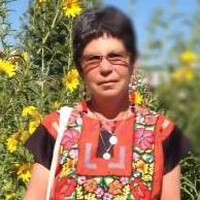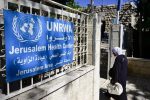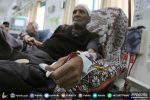In September 2004 Arun Gandhi’s visit to Palestine revived conversations about the role of nonviolence in the Palestinian liberation struggle. In March 2019 he will return only this time he will give a lecture at Habima Theater in Tel Aviv as part of a promotional book tour again advocating the concept of non-violence. His message will most likely spark more dialogue this time not so pleasant as he recently spoke out against “narrow nationalism” that he believes generates “hate and prejudice” that inevitably leads to a “culture of violence.”
In an article aptly titled “The Myth of Gandhi and Palestinian Reality” Ali Abunimah evaluates its potential as a useful strategy for Palestinians. While admitting that Indians used any means necessary to achieve independence including “terrorist acts” Abunimah views Gandhian measures as a way to “energize the freedom struggle.” Abunimah distinguishes though between Palestinians who employ nonviolent means and how he views Israelis “whose calls for nonviolence are simply another bankrupt exercise in shifting the blame from the occupier to the occupied while still posing as advocates for peace.”
Rather than asking why there is no such Palestinian leader it might be more instructive to ask when will Israel stop assassinating disabling and imprisoning potential Gandhis. Most Palestinian families have had at least one member detained in Israeli prisons. There are approximately 5000 Palestinian currently in detention.
For example when Charlotte Silver covered the arrest of Issa Amro activist and organizer in occupied Hebron she titled the piece “Israel Indicts ‘Palestinian Gandhi’” an appropriate description of an indictment that included petty incidents going back six years to 2012. The founder of Youth Against Settlements Amro is among many human rights defenders who are intimidated in this way by Israel. Since 1967 800000 Palestinians approximately 40 percent of the male population have been incarcerated in Israeli jails.
Not only does Israel engage in such activity but it also seeks to undermine Boycott Divestment Sanctions (BDS) a non-violent movement modeled on the anti-Apartheid struggle in South Africa. For example it has imprisoned Palestinian journalists and threatened to revoke permits of internationals who support BDS. In this way Israel hopes to replace their accounts with propaganda of its own.
Nevertheless as Ghada Ageel explains since the 1930s nonviolent resistance has been part of Palestinian history. For example in the West Bank village of Bilin there has been an ongoing struggle against the Separation Wall. Captured in Five Broken Cameras a documentary which traces a year of popular resistance it continues on a weekly basis to this day. The film focuses on the destruction of Emad Burnat’s cameras by Israelis a sequence that also mirrors the first five years of Burnat’s youngest son Jibreel. It is of course a one-sided film a powerful personal story because there is only one side for Emad the struggle for peace and dignity. Nominated for an academy award in 2013 the film had a tremendous impact on public opinion.
Why did the Israeli military target Emad’s camera? For the same reason that journalists in dangerous areas around the world are targeted: their cameras bear witness to the truth. There is a saying among Palestinian activists: “Existence is resistance.” For Emad witnessing with his camera was a healing experience I think because the camera enabled him to use his voice to transform his identity from victim to someone with the right to own his story. In an interview with Jonathan Robbins he asserts: “Healing is a challenge in life. It is a victim’s sole obligation. By healing you resist oppression.”
He adds that the camera was also a source of communal healing a collective memory that all Palestinians in his village share. As Ramzy Baroud explains beyond individual forms of resistance there is a kind of “collective psychology” that inspires nonviolent struggle. In this way Baroud continues the oppressed are transformed from “hapless victims” to “agents of change” makers rather than the subjects of history.
Nevertheless Palestinians are often caught in a double bind. Non-violent resistance is the strategy of choice for some like Emad and his brother Iyad because they feel that it draws international support. There is violence of course but it is against the unarmed protesters. As Neve Gordon explains there is a “vast asymmetry in power relations between the colonizer and colonized.” Indeed Israel has maintained its “colonial project” through “attritional protracted and widespread violence” funded by Western powers.
Although the United Nations has affirmed “the legitimacy of the peoples’ struggle for liberation from colonial and foreign domination and alien subjugation by all available means including armed struggle” when Palestinians employ that legal right they are cast as inherently barbarous by mainstream media. In her latest book Freedom is a Constant Struggle: Ferguson Palestine and the Foundations of a Movement (2016) those who insist on calling Palestinian resistance a form of terrorism end up erasing important issues in the struggle for liberation and self-determination (p. 8).
Without the land there is no story and that is partly why Emad made this film to put Palestine as he explains on the map of the world. On Land Day March 30 2019 the Great Return March will commemorate its one year anniversary. That too has placed Gaza on the world stage.
For the past 12 months Gazans have been demonstrating for an end to the blockade as well as their legal right of return. 70 percent of Gaza’s population includes refugees expelled during the Nakba (catastrophe) of 1948 along with their descendants like Haider Eid an associate professor at Al-Aqsa University in Gaza. Eid explains that the protest represents “our long walk to freedom” a comparison to the civil rights movements in the American South.
Nearly 250 unarmed Palestinians have been murdered and thousands more maimed and injured by Israeli snipers since the protests began. Nevertheless these demonstrations have demonstrated Palestinian sumoud (resilience) and also their desire to celebrate traditions culture and history. By sharing songs traditional dances and meals they keep alive the memories of their homeland.
In 2017 the Gandhi Peace Award was given to Omar Barghouti who then dedicated the award to all political prisoners on hunger strike in Israeli jails. Indeed the strike leader Marwan Barghouti has just written an op-ed in the New York Times in which he charges that the courts are a “charade of justice” an instrument of colonization that criminalizes Palestinians’ very existence.
Nevertheless Palestinians are assuming their rightful place at the center of their struggle. Placing the Return March within a broader framework Baroud regards their resistance as a “collective statement a cry for justice an ultimate reclamation of their narrative as a people”—still resilient after “70 years of Nakba 50 years of military occupation and 12 years of unrelenting siege.”
Moreover movements like the Return March are grassroots campaigns in which every person is a leader with no need for a Mandela to guide them. The question then becomes not where are the Palestinian Gandhis but where is the recognition of their voice.
– Benay Blend received her doctorate in American Studies from the University of New Mexico. Her article “On the Meaning of Sumoud” will appear in Palestine Chronicle on March 30 2019 in conjunction with the one-year anniversary of the Great March of Return. Her article appeared in Palestine Chronicle.











